"Real vs. Fake Rolex: 10 Undeniable Differences Even Experts Miss (2024)"
Let’s start with a fun fact: There are more fake Rolexes in the world than genuine ones—which is pretty hard to believe. The sheer number of counterfeit watches on the market not only causes major headaches for consumers looking to buy the real deal but also damages the reputation of high-quality Rolex replicas, since most knockoffs are poorly made.
As a leading supplier of Rolex replica watches, we offer affordable reproductions and super clone-grade replicas. While we’re glad to see so many Rolex-inspired watches out there, we strongly oppose cheap fakes because they hurt the entire industry.
In this article, we’ll break down the differences between Rolex replicas and the genuine article. We won’t even bother discussing low-quality counterfeits because the differences aren’t subtle—they’re not just cosmetic but extend to quality, weight, shape, and color. Instead, we’ll focus on watches from our collection, including budget-friendly replicas and super clones.
One thing to note: The idea of a "1:1 perfect replica" is a myth—or more accurately, a marketing term. Even the highest-tier replicas have minor differences. These aren’t flaws in quality but subtle distinctions, like the sound of a rotating bezel, slight variations in color on vibrant dials, and other small details we’ll explore here.
Can You Spot a Fake Rolex?
Before we dive into the six key ways to tell, let’s put your eye to the test. Below, you’ll see images of real and fake Rolex watches—click on the one you think is authentic.
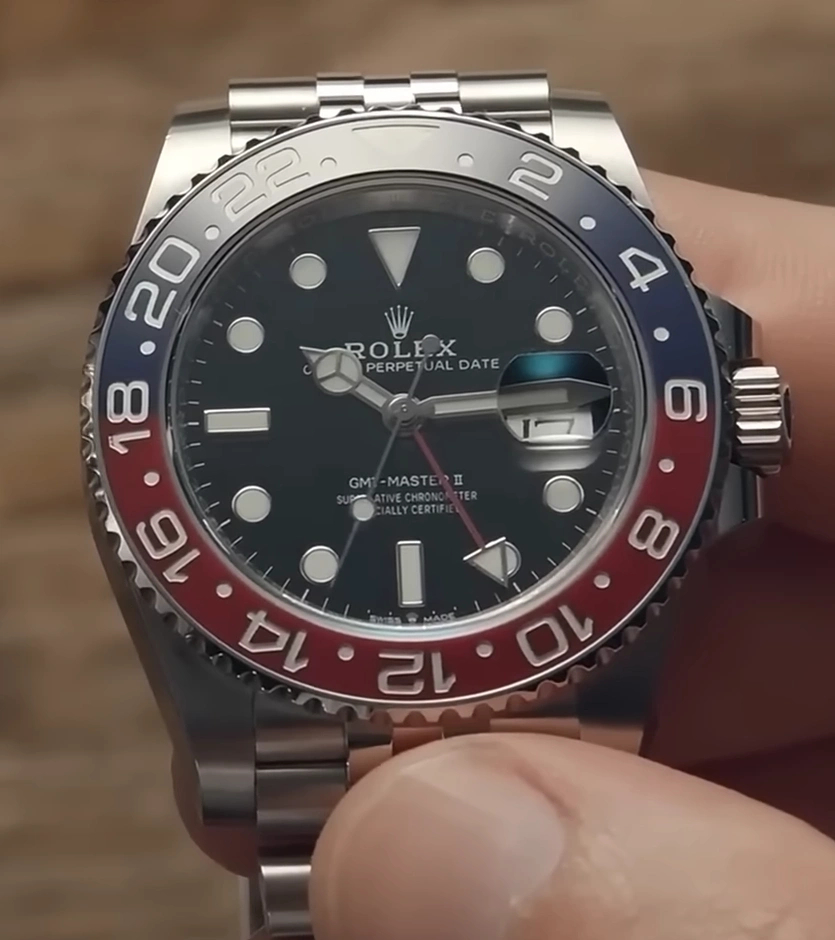
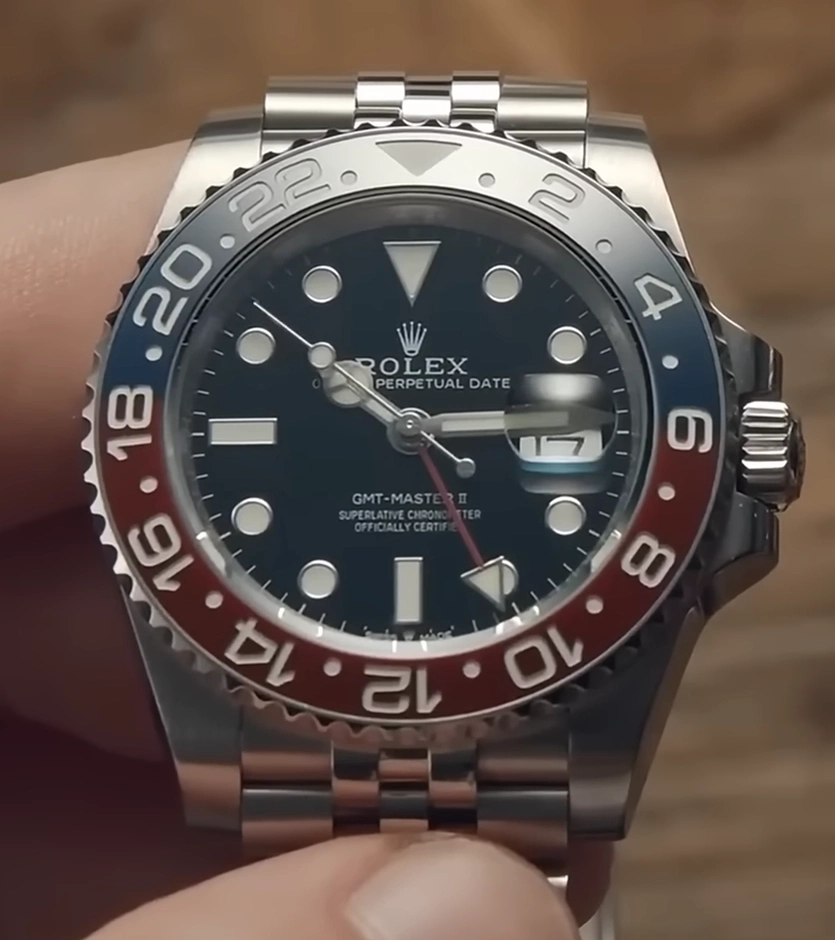

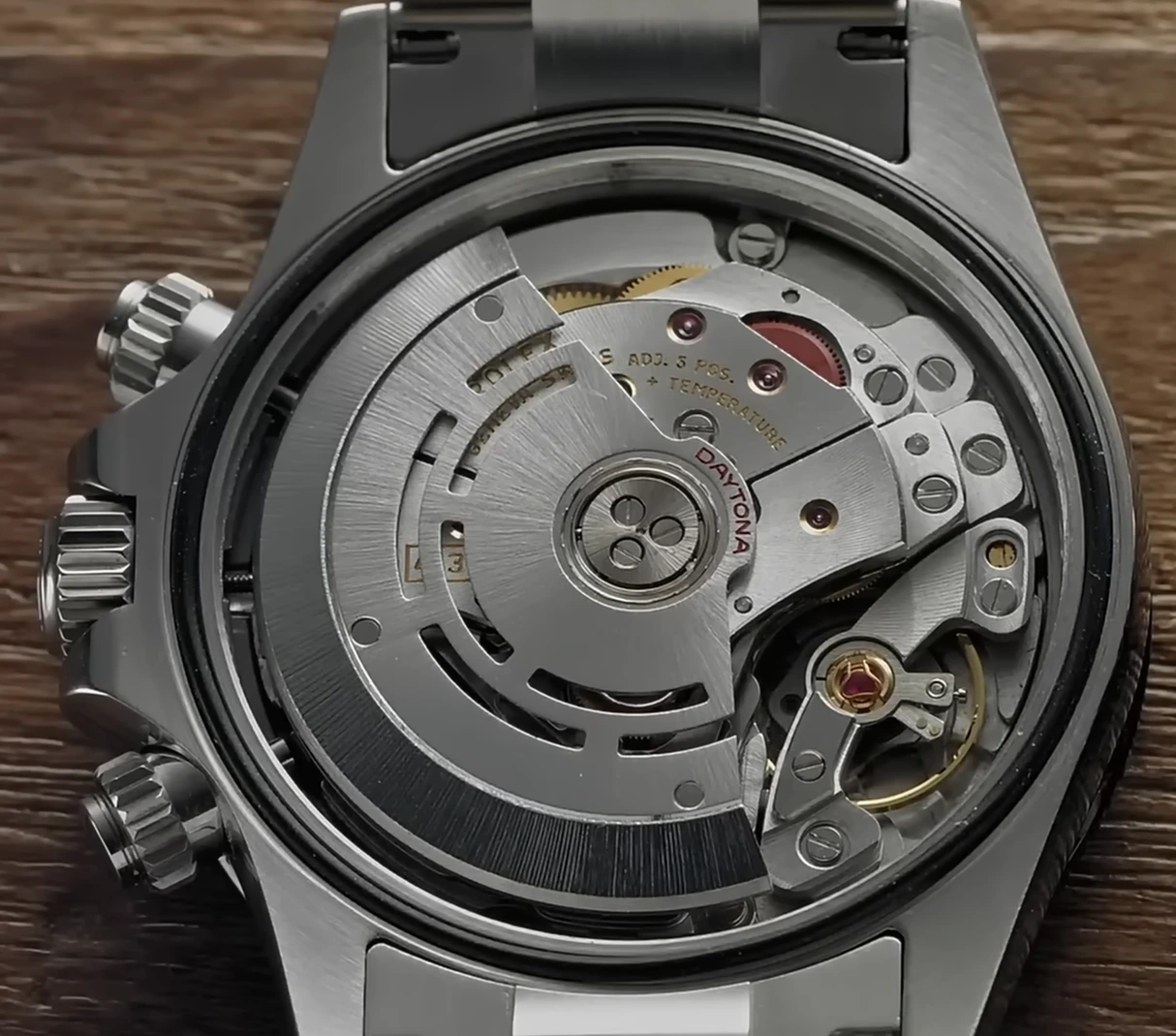
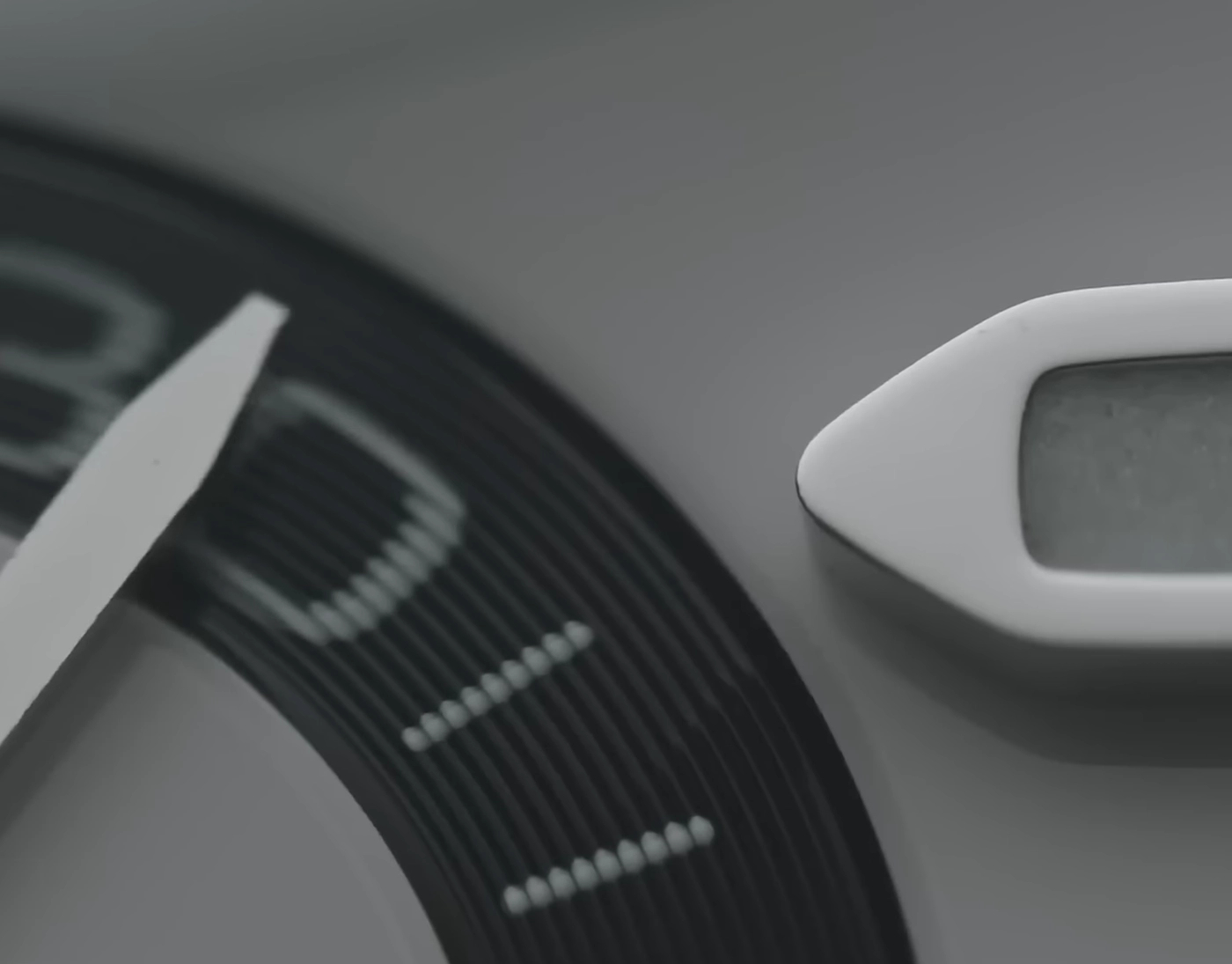
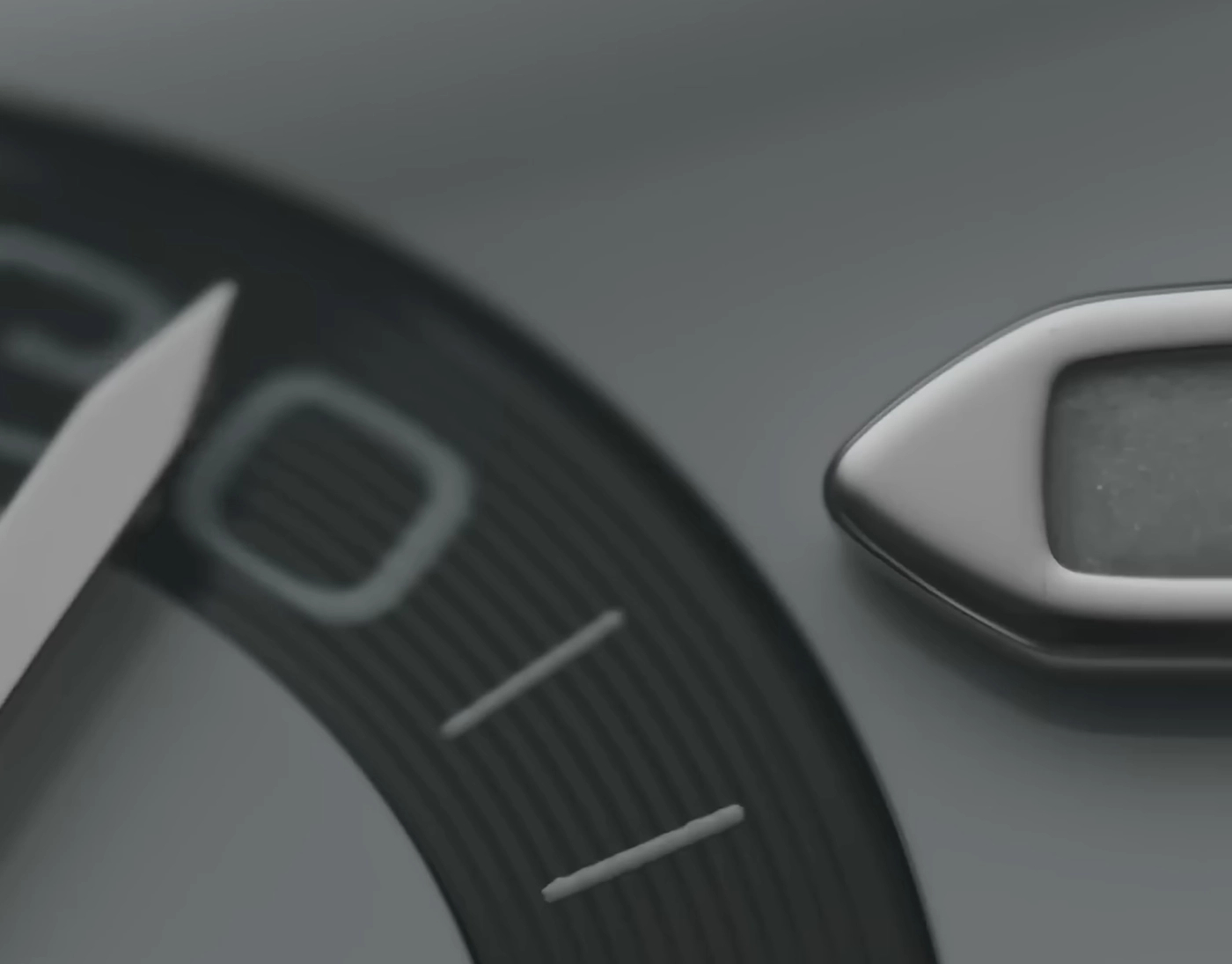


Did you guess correctly?
We intentionally chose close-up angles and highlighted the subtle differences we mentioned earlier—otherwise, the watches would look nearly identical, leaving you to rely on pure luck.
But here’s the second reason why spotting a fake Rolex is so tricky: Even genuine Rolexes aren’t perfect. Despite the brand’s legendary craftsmanship and attention to detail, you’ll occasionally find misaligned components, uneven finishing, or tiny imperfections—whether on the case, dial, or even the hands.
How to Spot a Fake Rolex Using Serial Numbers
The Serial Number Test
Every genuine Rolex has a unique serial number. Before 2010, these numbers could even help date the watch. However, Rolex switched to randomized serials after 2010, making dating impossible.
How to Check:
-
Take the serial number (found between the lugs on the side of the case).
-
Search it on Google with quotation marks (e.g., "Z754008") to ensure exact matches.
-
If multiple listings or forum discussions appear with the same serial number (especially across different models), the watch is likely fake.
Example:
Searching "Z754008" brings up listings for both a Submariner (Black) and a Two-Tone model—a clear red flag.
Note: Just because a serial number doesn’t show up online doesn’t guarantee authenticity. Some fakes use unlisted numbers.
Replica Serial Numbers: Budget vs. Superclone
-
Budget replicas often reuse the same serial number across many watches (cost-saving measure).
-
High-end Superclones (like ours) typically use unique or limited-batch serials to mimic genuine Rolex practices.
⚠️ Important: While our Superclone Rolexes often have unique serials, we strictly prohibit selling them as authentic. Replicas are for personal enjoyment—not fraud. Let Rolex handle their own pricing; don’t scam others.
Fun Fact:
From 1987–1990, Rolex embedded "RLX" (dropping the "O" to avoid confusion with zero) into their serial sequences.
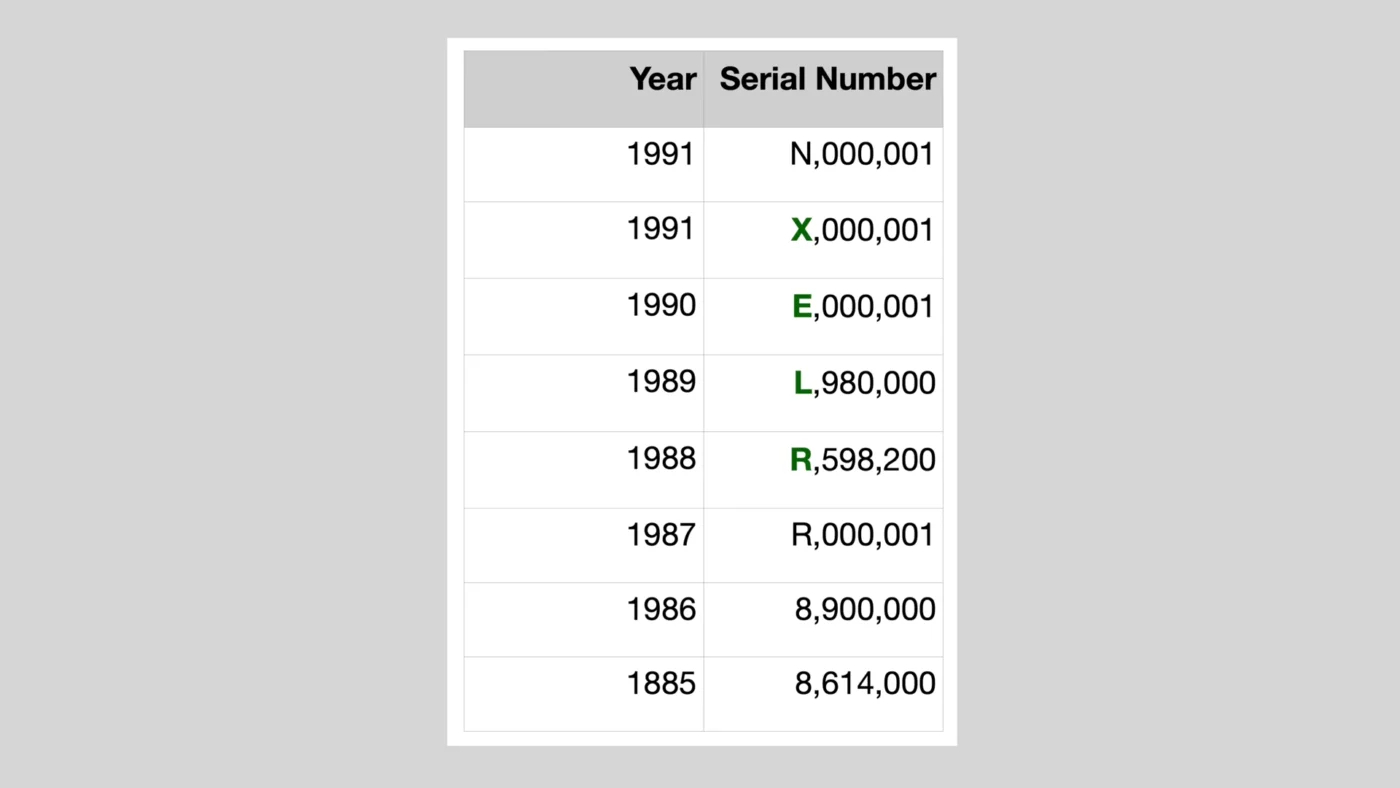
The location of a Rolex's serial number depends on its age:
-
Vintage Rolex (Pre-2005): The serial number is engraved between the lugs at the 6 o'clock position. You'll need to remove the bracelet to see it.
-
Modern Rolex (2005-Present): Rolex moved the serial number to the rehaut (the inner rim of the dial) at 6 o'clock. This "rehaut engraving" is visible without removing the bracelet.
Note: Transitional models from 2005-2008 may have the serial number in both locations as Rolex phased in the new system.
This rewrite improves clarity and flow while maintaining all key information. The bullet points make it easier to scan, and the added note about transitional models provides helpful additional context for collectors.
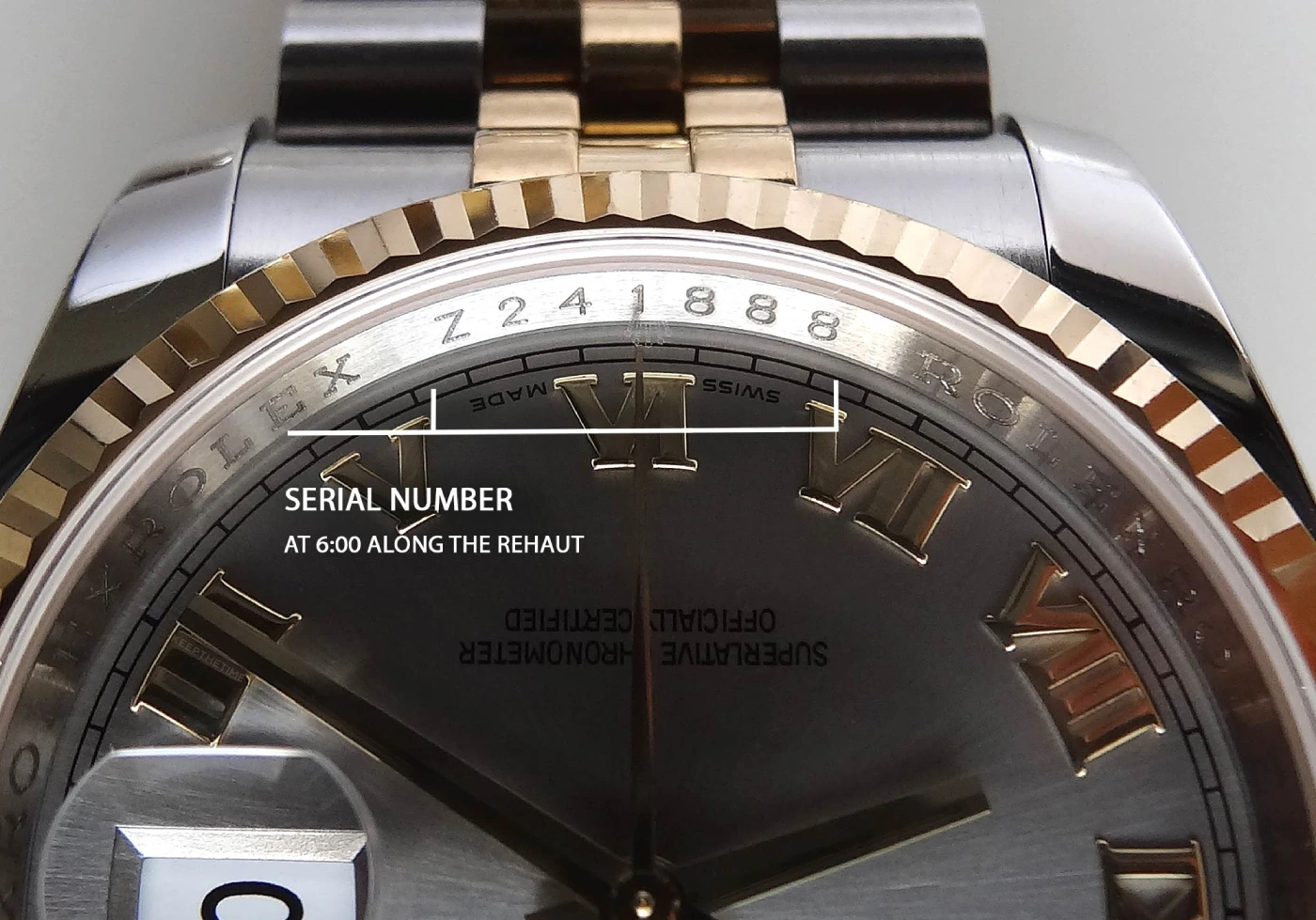

The Rolex Cyclops: A Telltale Sign of Authenticity
The Cyclops date magnifier is one of Rolex's most iconic features - and one of the hardest for counterfeiters to replicate perfectly. Here's what sets the genuine article apart:
-
Precise 2.5x Magnification
Authentic Rolex watches (like the Submariner) magnify the date exactly 2.5 times, making it appear large and perfectly proportioned in the window. -
Crystal-Clear Legibility
-
No distortion or skewing of the date numerals
-
Sharp edges with no blurriness
-
Consistent alignment within the date window
-
-
Advanced Anti-Reflective Coating
Rolex applies a nearly invisible anti-reflective coating beneath the Cyclops. Many replicas either:-
Miss this coating entirely, resulting in glare
-
Use inferior coatings that create a slight blue/purple tint visible at certain angles
-
Why Most Fakes Fail:
Lower-quality replicas often get the magnification wrong (typically under-magnified) or use inferior materials that distort the date. Even high-end "super fakes" frequently miss subtle details like the proper anti-reflective treatment.
Pro Tip: Tilt the watch under light - a genuine Rolex Cyclops will maintain clarity without color shifts, while fakes often reveal their flaws through distortion or tinting.
This version organizes the information more effectively, adds specific details, and makes it easier for readers to understand and remember the key authentication points. The bullet points and bold headers improve readability while maintaining all the technical accuracy of your original text.
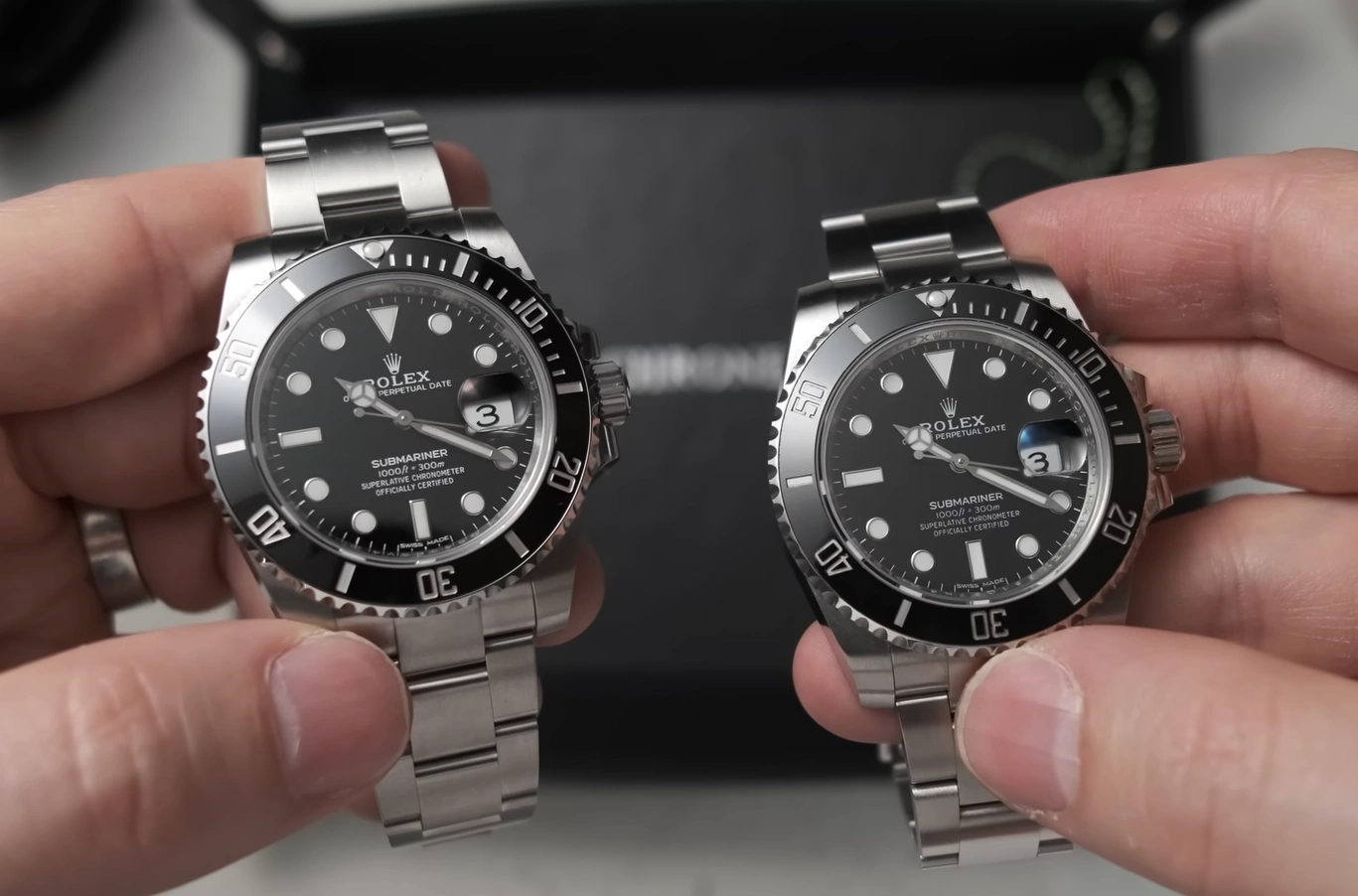
For the date font itself, to verify it you would need an authentic watch to compare side by side. Usually the font is pretty much the same, however, under detailed inspection, some numbers might have giveaways, like this peak in this particular number 3.

The Rolex Laser-Etched Crown: A Microscopic Marvel of Authenticity
Let's geek out on one of Rolex's most sophisticated security features - the nearly invisible laser-etched crown at 6 o'clock. This tiny detail separates the masters from the imitators.
What Makes It Special:
-
Precision-etched using advanced laser technology
-
Virtually undetectable to the naked eye
-
Only visible under magnification (10x or higher) or angled lighting
-
Composed of microscopic dots at varying depths within the sapphire crystal (not a continuous line)
How to Spot a Fake:
-
Missing Entirely - Most budget replicas omit this feature completely
-
Poor Execution - Mid-tier fakes often:
-
Use engraving instead of true laser-etching
-
Make the crown too large/visible
-
Lack the multi-depth dot matrix pattern
-
-
Overdone Visibility - High-end replicas may have the crown but make it too prominent
Professional Verification Method:
-
Use a jeweler's loupe (10x magnification minimum)
-
Shine a bright light at an acute angle to the crystal
-
Look for:
-
Perfectly formed crown shape
-
Subtle dot matrix composition
-
No surface scratching (true etching is inside the crystal)
-
Why It Matters:
This feature represents Rolex's commitment to microscopic perfection. The complex dot-matrix etching requires specialized equipment that counterfeit operations typically can't access or execute properly.
Pro Tip: If you can see the crown clearly without magnification, it's likely fake. The genuine etching is designed to be found, not obvious.
This version maintains all technical details while improving organization and readability. The bullet points and clear sections make the information more digestible, and the added "Why It Matters" section reinforces the significance of this authentication feature.
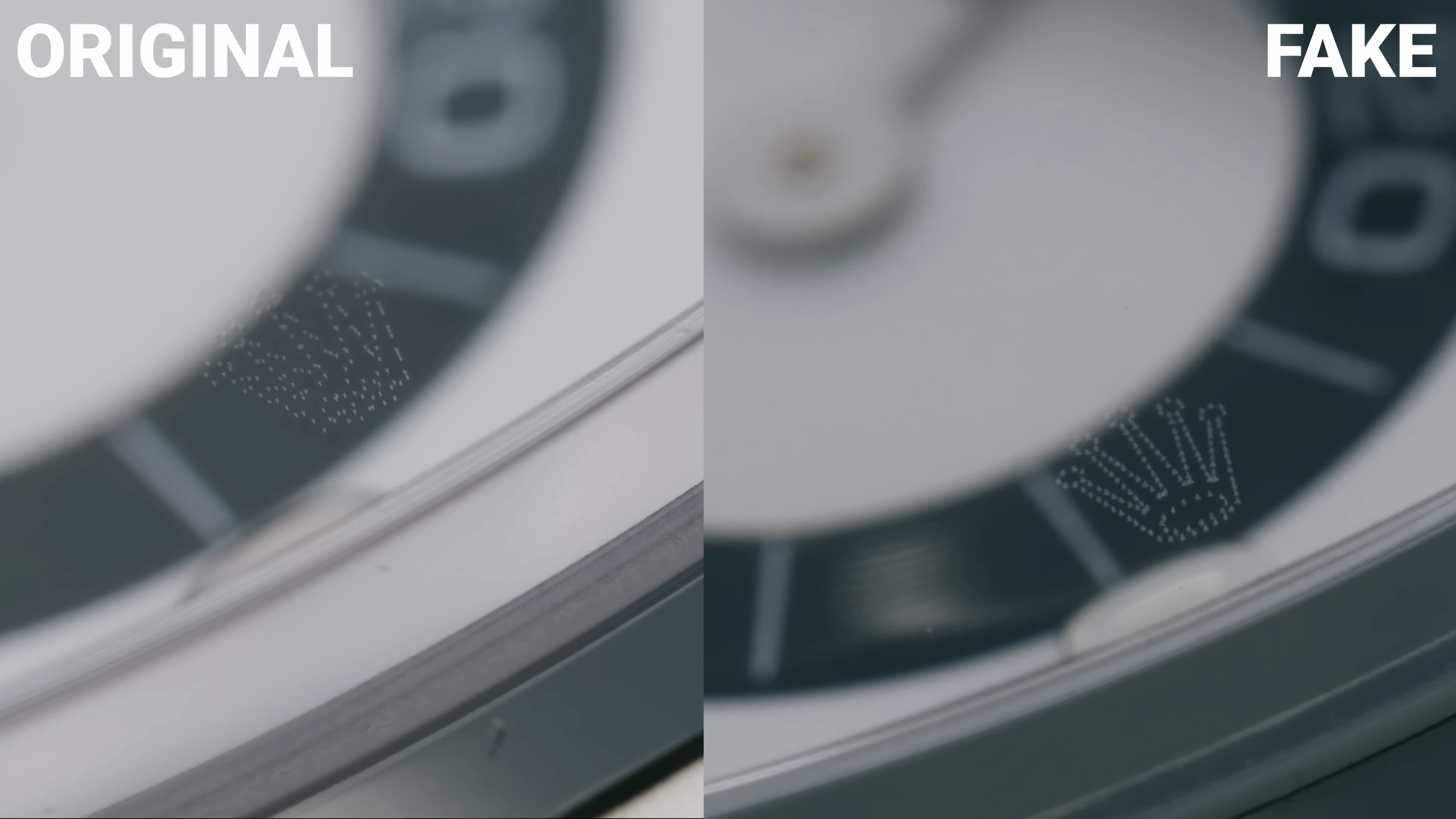

The Rolex Rehaut: A Masterclass in Precision Engraving
The rehaut—the inner ring between the dial and crystal—is one of Rolex’s most refined details. Here’s how to spot the real deal:
Key Authentication Points
-
Laser-Perfect Engraving
-
Genuine Rolex: The "ROLEX" text is laser-etched with microscopic precision—sharp, even, and flawlessly aligned.
-
Fake Giveaways:
-
Uneven or overly deep engraving
-
Thick, dark lines in the lettering (a sign of inferior laser work)
-
Misaligned text or crown logo
-
-
-
Correct Layout
-
12 o’clock: Rolex crown logo
-
6 o’clock: Serial number (on modern models)
-
All text is perfectly centered and evenly spaced
-
-
Evolution Over Time
-
Older Rolex models may not have rehaut engraving at all.
-
Modern Rolexes (mid-2000s onward) feature this as a standard anti-counterfeit measure.
-
How to Check?
-
Use a Macro Lens (10x+ Magnification):
-
Compare lettering sharpness and depth.
-
Look for inconsistencies in spacing or alignment.
-
-
Side-by-Side Comparison:
-
Even high-end replicas often fail to match Rolex’s laser precision.
-
Pro Tip: If the engraving looks too obvious or crude under normal light, it’s likely fake. Rolex’s etching is subtle—meant to be seen, not shouted.
This version keeps the technical depth while making it easier to digest with clear headers and bullet points. The "Pro Tip" adds a quick-check takeaway for readers.
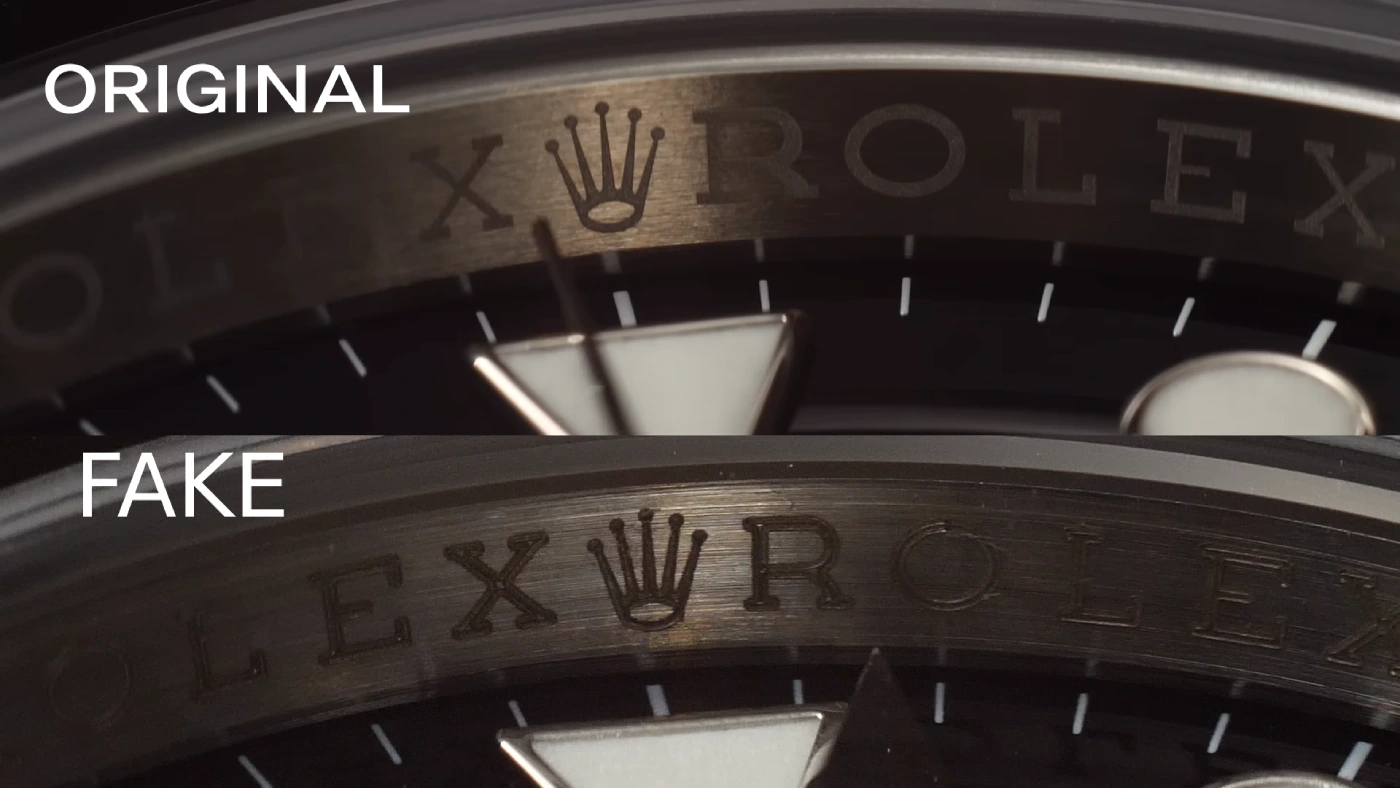
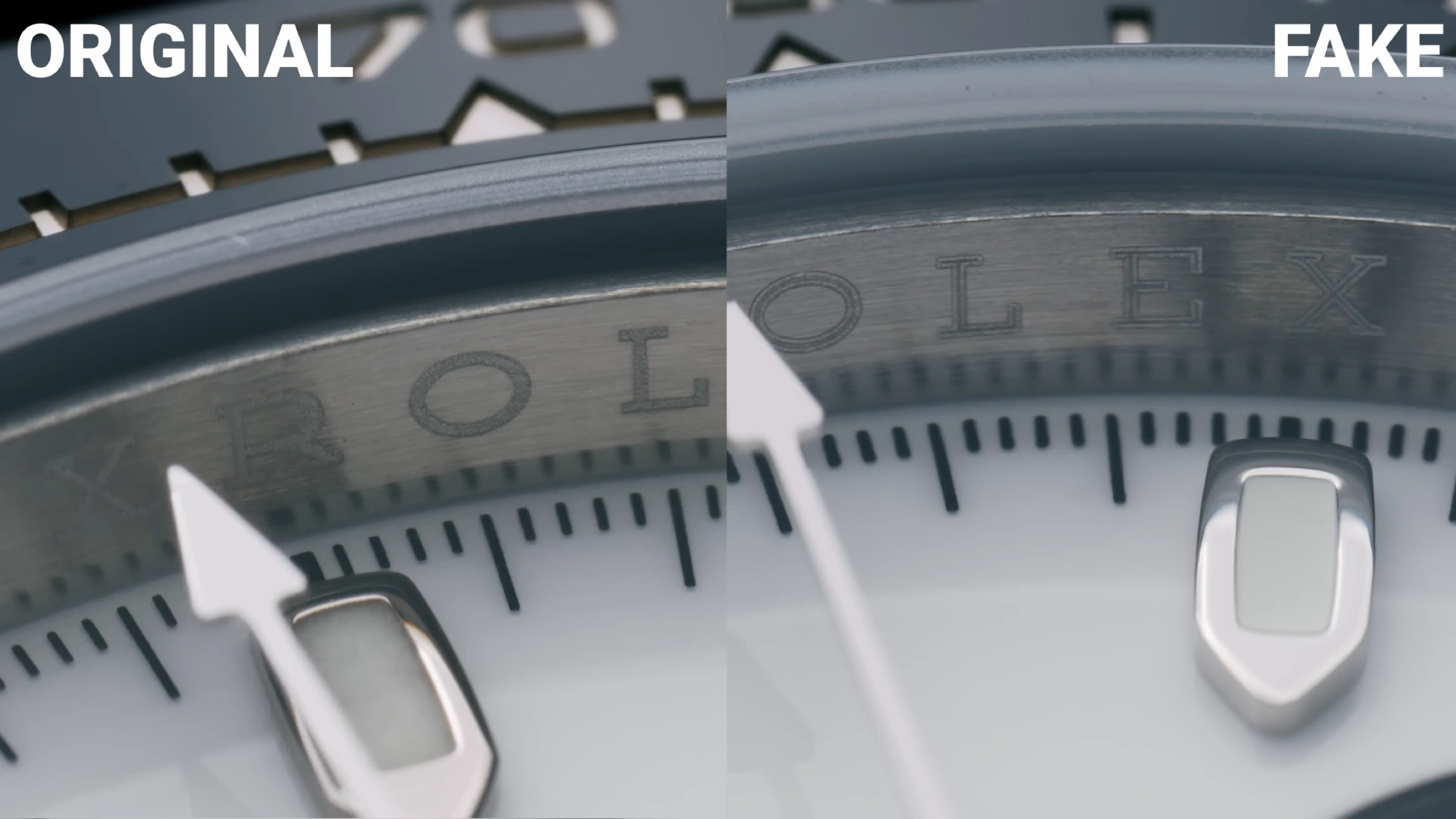
Another thing to look out for is, on the right-hand side of the dial, one o’clock down to five o’clock, the “X” of “Rolex” is going to line up with the hour markers. On the left-hand side of the dial, so seven o’clock up to 11 o’clock, the “R” of “Rolex” is going to line up with the hour markers. Sometimes, even higher-end superclones get the positioning wrong.
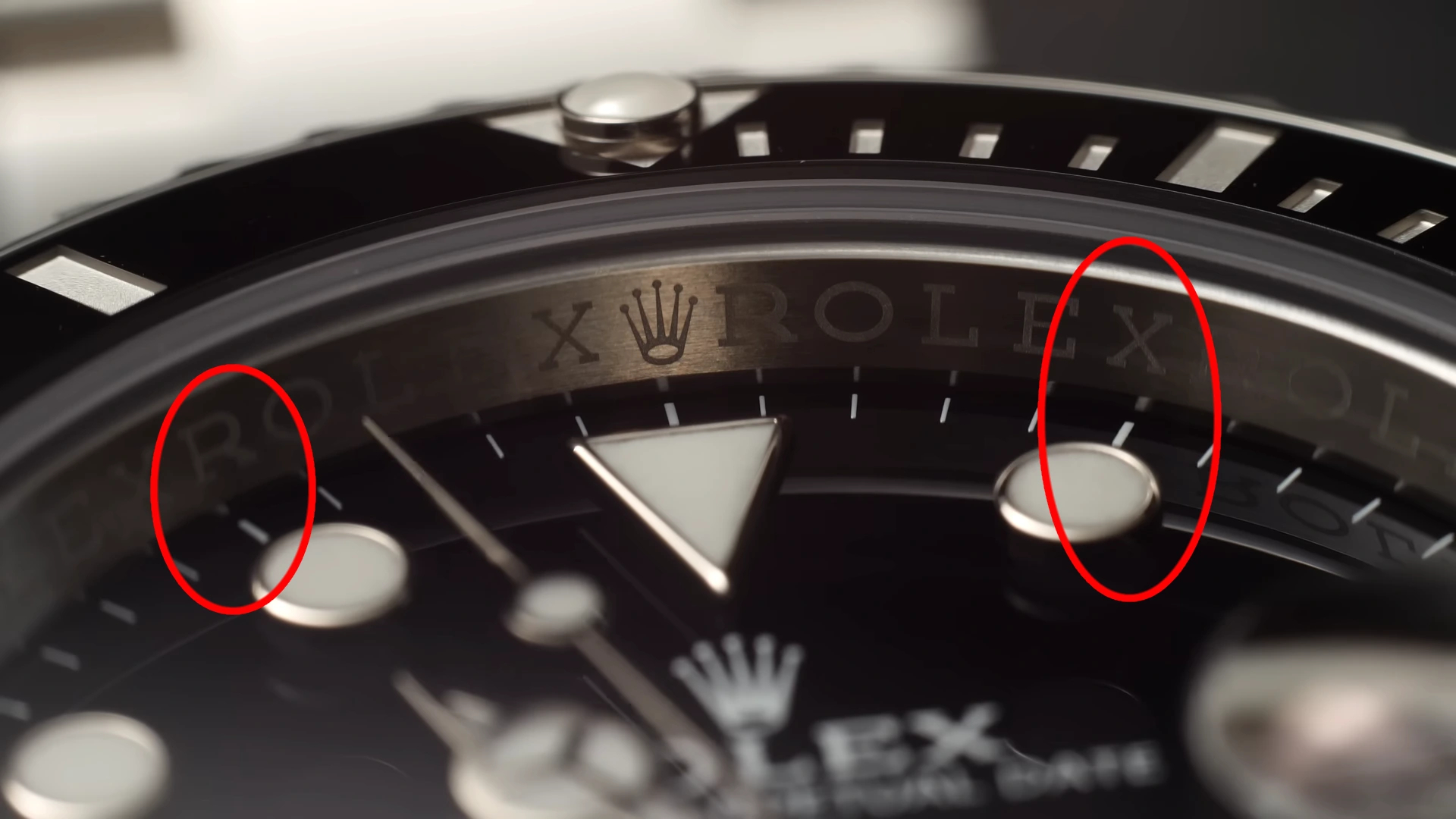
Rolex Finishing: The Devil's in the Details
Rehaut Engraving Timeline
-
Pre-2004 Models: No rehaut engraving present
-
2004 Onward: Laser-etched "ROLEX" text and serial number added as standard
The Art of Rolex Finishing
-
Brushed Surfaces
-
Genuine Rolex watches feature ultra-fine, perfectly parallel brushing
-
Even high-end superclones struggle to perfectly replicate:
-
The exact grain consistency
-
Uniformity across all brushed surfaces
-
-
Most noticeable difference: Clasp brushing (requires magnification to spot)
-
-
904L Steel Challenges
-
While both genuine and premium replicas use 904L steel:
-
Rolex's proprietary finishing techniques create smoother surfaces
-
Replicas often show slightly coarser grain under magnification
-
-
-
Polished Surfaces
-
Should be mirror-perfect with no visible tool marks
-
Common replica flaws:
-
Microscopic waviness in polished areas
-
Uneven bevel edges
-
-
Authentication Tips
-
Use 10x magnification to examine brushing patterns
-
Compare to an unworn genuine piece (wear alters finishing over time)
-
Focus on the clasp - most replicas show subtle imperfections here
Pro Tip: Run your fingernail across brushed surfaces - genuine Rolex finishing feels like ultra-fine silk, while even good replicas often feel slightly grainier.
This version organizes the information more clearly while maintaining all technical details. The addition of a tactile authentication method (fingernail test) provides a practical verification technique beyond visual inspection.
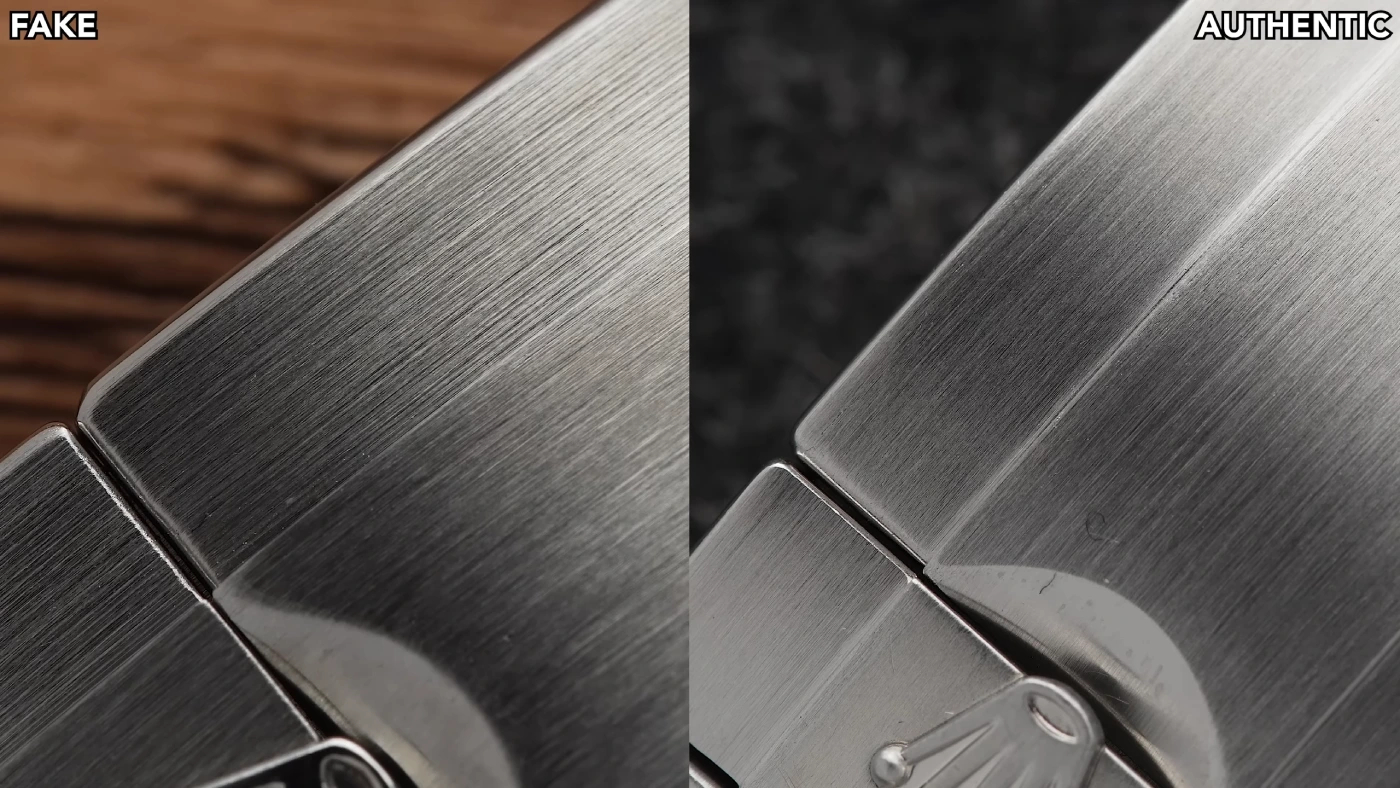
Note, that this photo is done using an ultra macro lens, for the purpose of comparison, here is a photo of two buckles from an authentic and Replica Rolex Daytona.
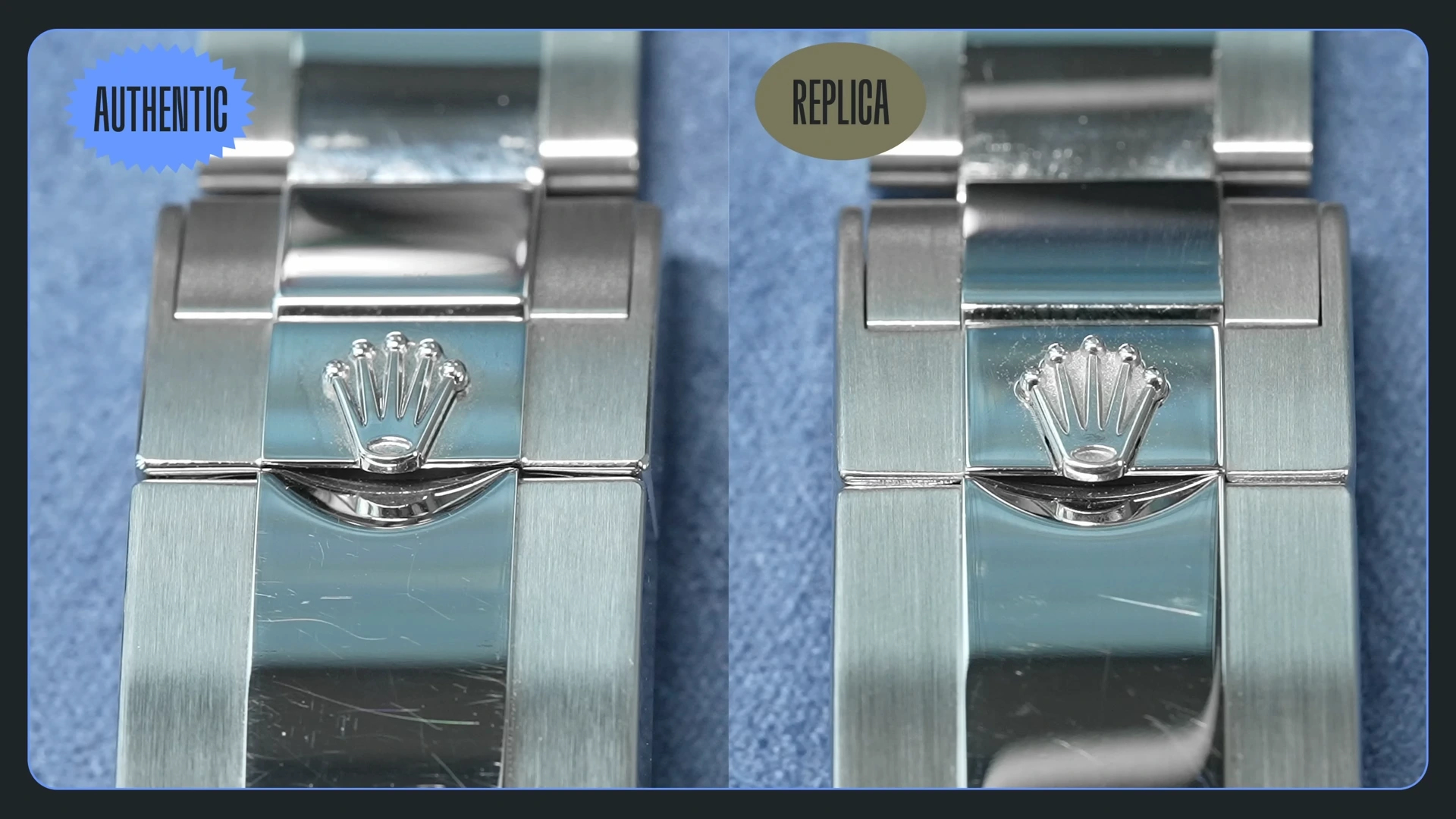
Inside a Replica Rolex: The Movement Breakdown
When evaluating high-end replica Rolex watches, the movement is where manufacturers face their biggest challenge – and where the price differences become most apparent. Here's what you need to know:
Movement Tiers in Replica Watches
1. Entry-Level (Miyota/Chinese Clones)
-
Common Movements:
-
Japanese Miyota 8205/8215
-
Chinese Clone 2813
-
-
Pros: Affordable, reliable timekeeping
-
Cons:
-
Noisy rotor (audible spinning)
-
Rough finishing (visible under inspection)
-
Decorated rotor to look like Rolex, but easily identifiable as fake upon closer look
-
2. Mid-Tier (ETA Swiss Movements)
-
Found in: Higher-quality replicas
-
Pros:
-
Swiss-made reliability
-
Smooper operation than Miyota/Chinese clones
-
-
Cons:
-
Still not a true Rolex clone (different architecture)
-
May lack key Rolex movement features (e.g., Parachrom hairspring)
-
3. Superclone (VR/VF Factory Movements)
-
Closest to Genuine Rolex:
-
Named after original movements (e.g., VR3135, VS3235)
-
Replicated balance wheel, bridges, and rotor design
-
-
Pros:
-
Visually nearly identical to genuine Rolex movements
-
Improved power reserve and accuracy
-
-
Cons:
-
Slightly rougher finishing under macro lens
-
Long-term reliability not yet proven like Swiss originals
-
Why Movement Matters (Even with Closed Casebacks)
-
Timekeeping Accuracy: Better movements keep more precise time
-
Rotor Noise: Cheap movements are loud; superclones are nearly silent
-
Power Reserve: High-end clones mimic Rolex’s 70-hour reserve in some models
Our Stance on Replica Movements
We do not condone selling replicas as genuine—this guide is for educational purposes only. While superclone movements are impressively close, they still have minor differences in:
-
Finishing (less refined under magnification)
-
Materials (e.g., no true Parachrom hairspring)
-
Longevity (Swiss movements last decades; replicas are untested long-term)
Final Verdict:
For 5-10% of a genuine Rolex’s price, high-end replicas offer incredible value—but they remain homages, not authentic Rolex watches.
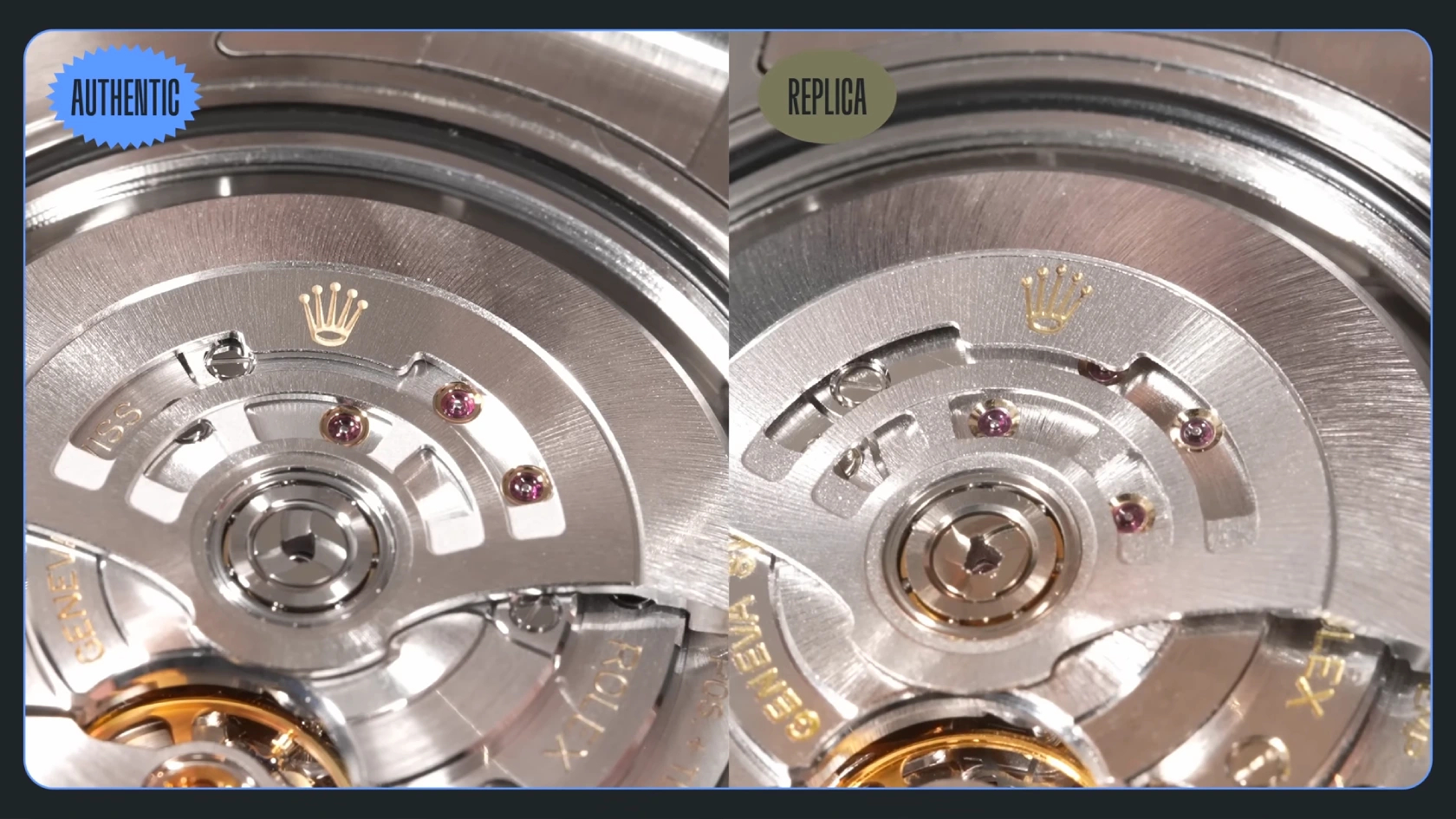
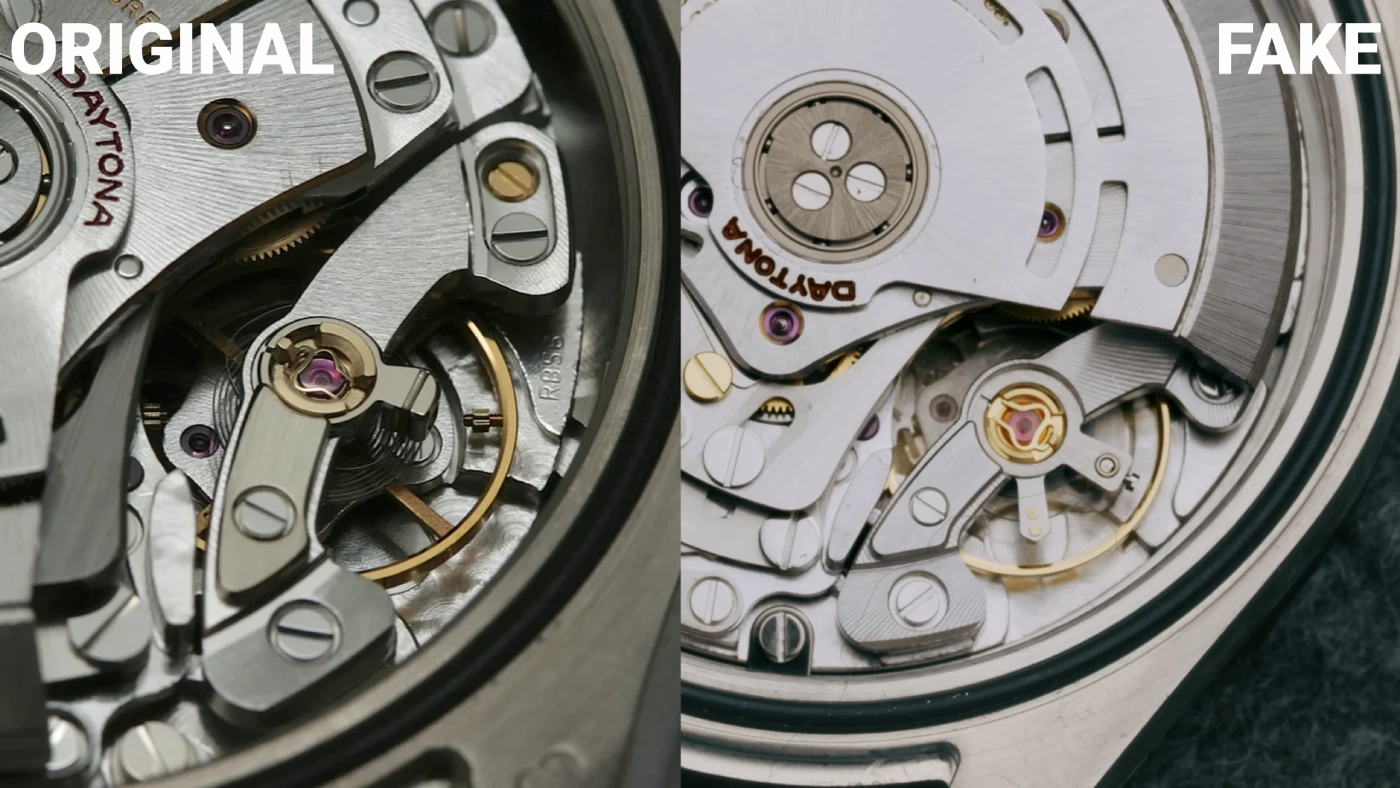
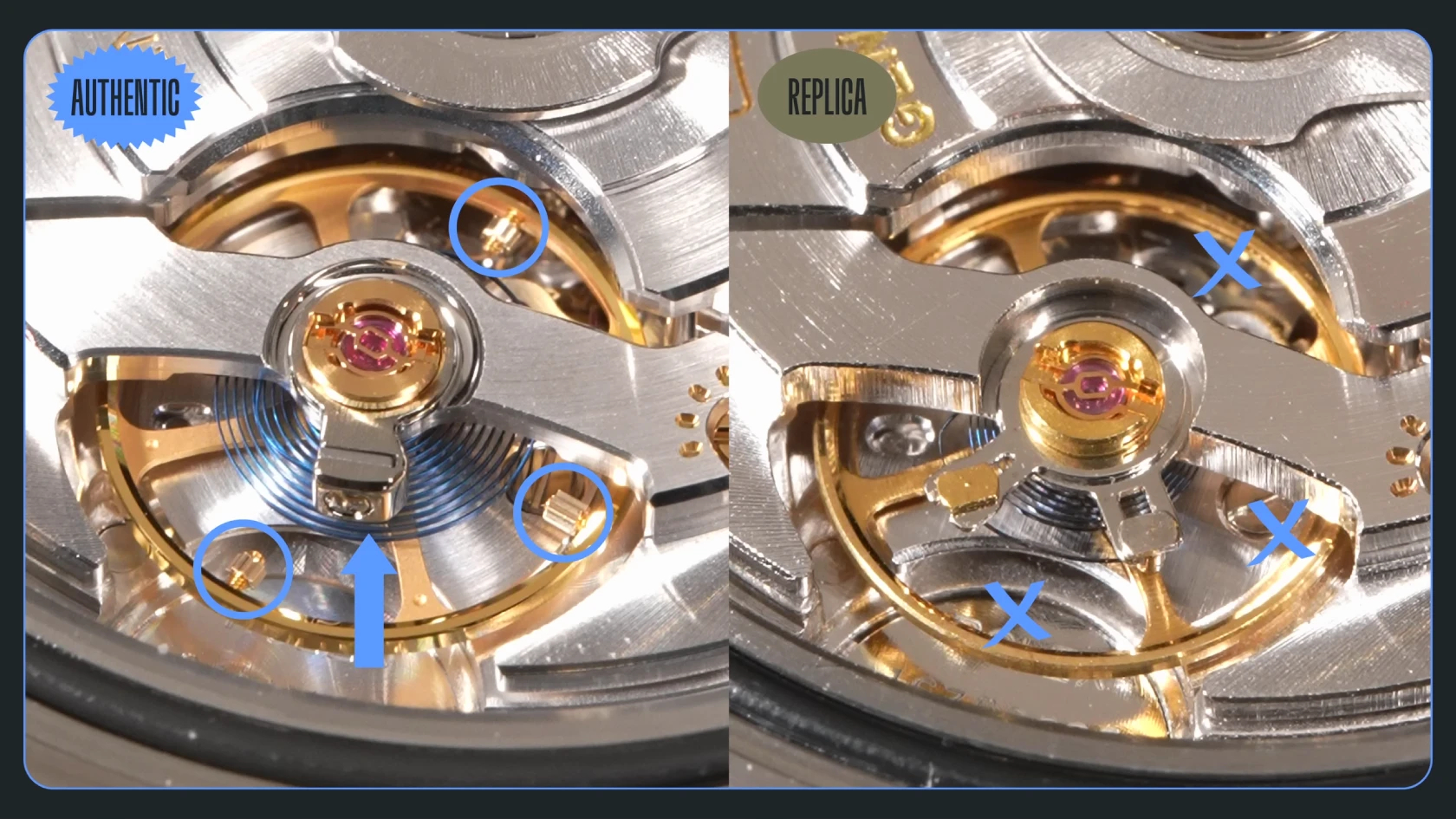
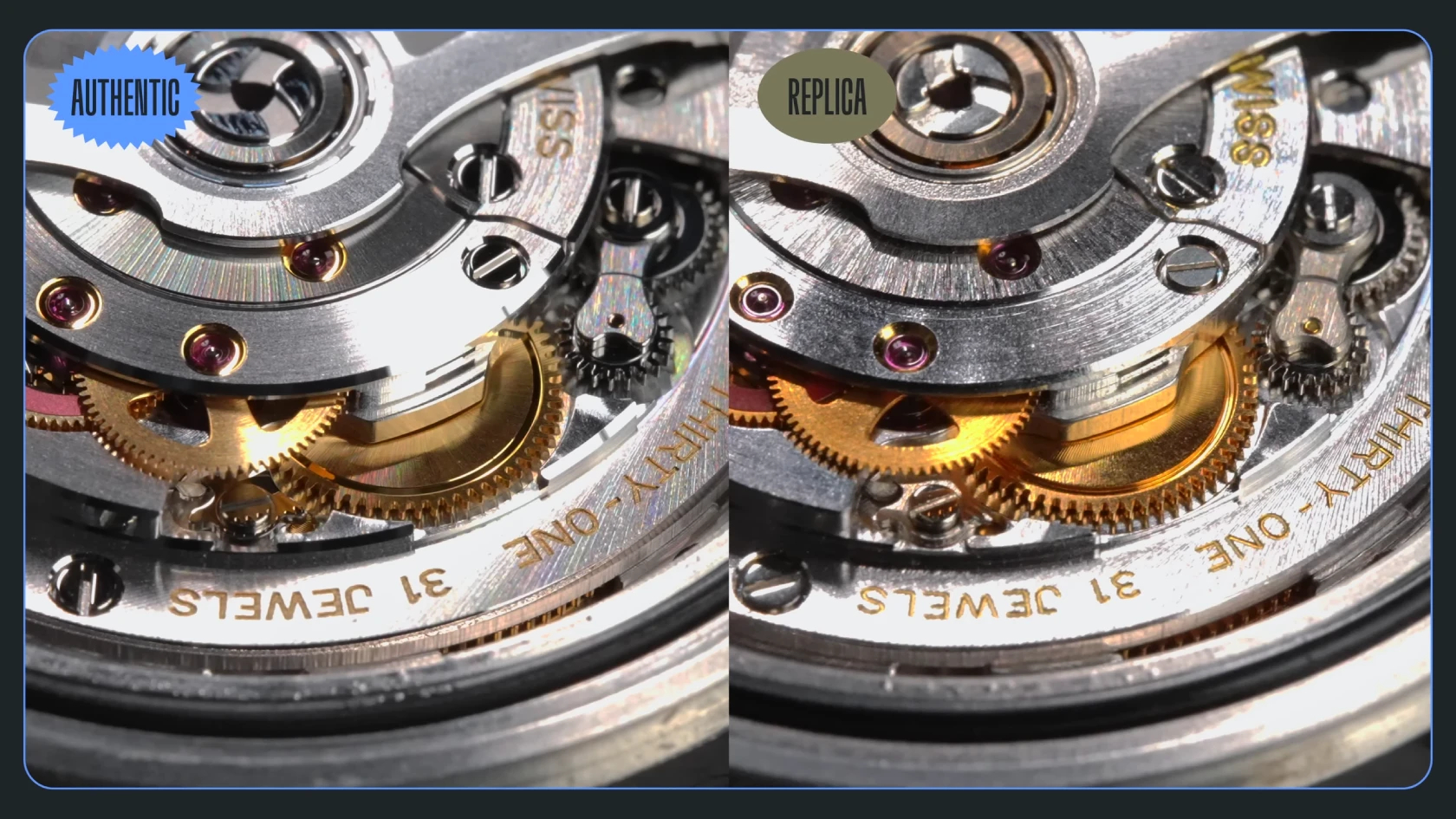
Spotting a Fake Rolex: Steel Quality & Clasp Details
1. 904L vs. 316L Steel – The Rolex Advantage
-
Genuine Rolex: Uses 904L stainless steel, known for:
-
Higher corrosion resistance (especially against saltwater)
-
Superior polish & shine (more lustrous than 316L)
-
Increased hardness (more scratch-resistant)
-
Distinctive weight & feel (denser than standard steel)
-
-
Most Replicas: Use 316L steel (cheaper, softer, less refined)
-
Telltale Signs:
-
Duller finish under light
-
More prone to scratches
-
Slightly lighter weight
-
-
Quick Test: Run your fingernail across the bracelet—genuine 904L steel feels smoother and more refined.
2. Clasp Hook – A Hidden Authentication Point (Newer Submariners)
-
Genuine Rolex:
-
The clasp hook is precision spot-welded (not glued or roughly soldered)
-
Welding points are evenly spaced, flawless, and discoloration-free (Rolex controls heat to prevent tempering marks)
-
-
Fake Rolex:
-
Often shows uneven welding, discoloration, or rough solder marks
-
May have visible glue residue (cheaper replicas skip welding entirely)
-
How to Check:
-
Use a 10x loupe to inspect the clasp hook’s base.
-
Look for uniform spot welds (no burn marks or misalignment).
Why These Details Matter
-
904L Steel = Exclusive to Rolex (even high-end replicas struggle to match its polish & durability).
-
Clasp Welding = A microscopic detail most counterfeiters overlook.
Final Tip:
If the steel feels lightweight or the clasp looks crudely attached, it’s likely a fake. Rolex’s craftsmanship leaves no room for imperfections.
This version keeps the technical accuracy while making it easier to scan with bullet points and clear comparisons. The practical tests (fingernail test, loupe check) help readers verify authenticity themselves.
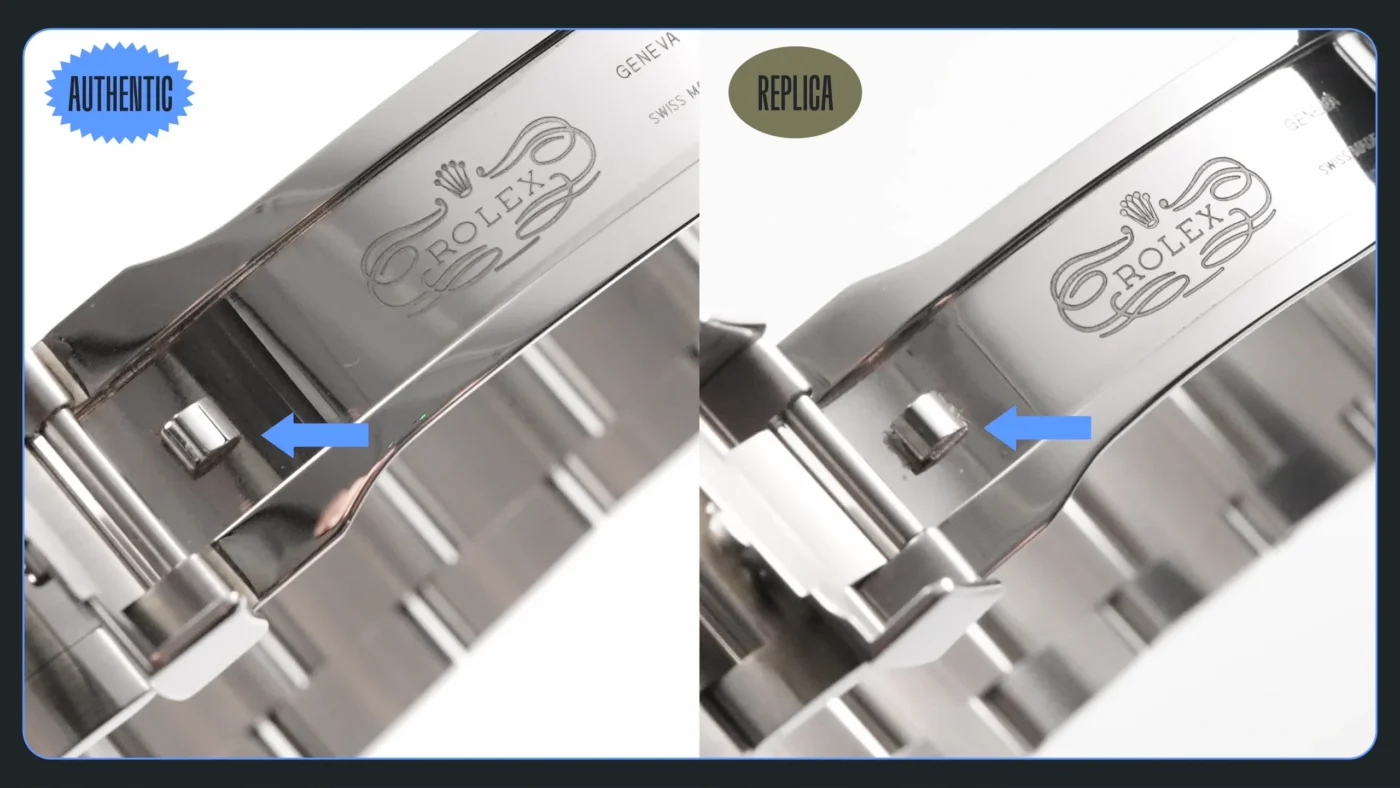
Weight & Size: Can You Feel the Difference?
1. Weight & Dimensions – The First Check
-
Cheap Fakes: Often noticeably lighter or bulkier due to inferior materials.
-
Superclones: Nearly identical in weight and size (differences <1-2%).
-
Example: A genuine Submariner weighs ~155g; top replicas are within 1-2g.
-
Minor variances can be blamed on:
-
Aftermarket servicing (misaligned parts)
-
Extra/removed bracelet links
-
Polishing wear over time
-
-
Tip: If a watch feels too light, it’s likely fake—but perfect weight doesn’t guarantee authenticity.
Franken Rolex: The 99% Replica
For perfectionists who demand that last 3% accuracy, Franken watches combine:
-
Replica base (case, bracelet)
-
Genuine Rolex parts (dial, hands, crown, movement components)
Why Franken Watches Are Rare:
✔ No mass market – Superclones satisfy 97% of buyers.
✔ Expensive & complex – Requires:
-
Sourcing rare authentic parts
-
Expert watchmaker assembly
✔ Legal risks – Selling as "genuine" is fraud.
Our Philosophy:
-
Replicas are for personal enjoyment, not deception.
-
Superclones offer 95-97% accuracy at 5-10% of the price.
-
Unless you’re a trained watchmaker, you likely won’t spot the difference.
Find Your Perfect Rolex Replica
Browse our catalog for 1:1 superclones—luxury craftsmanship without the luxury price.
Remember:
-
No replica is 100% perfect—but the best are closer than ever.
-
Buy for love, not fraud. Rolex’s value is in its heritage, not just its materials.



































































